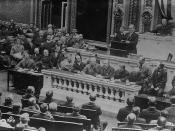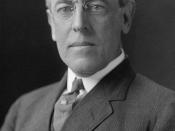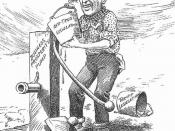As the United States advanced into the twentieth century, the Populists and Progressives saw numerous economic, political, and social problems in need of reform. The Populist movement was a result of a campaign by the Farmer's Alliance. Their chief organizer was a man named Ignatius Donnelly whose proposals were passed into law in the Progressive era. The Omaha Platform was adopted by the newly formed party and it called for the free coinage of silver. From an economic standpoint, the Populists hoped that this inflationary measure would eradicate the financial burden that plagued the nation's farmers. It also demanded reformation of the banking system, the graduated income tax, the secret ballot, the direct election of senators, and the eight-hour workday.
Similarly, the Progressive movement called for solutions to many economic ills in need of reform. The goal of most progressives was government regulation of business. Just as the populists had proposed years earlier, the progressives supported a graduated income tax, and a system to control currency.
In order to establish a system to control currency, the populists demanded the free and unlimited coinage of silver and gold at a ratio of sixteen to one, and that the circulating medium should be increased to at least fifty dollars per capita. At the height of progressivism, President Woodrow Wilson signed the Underwood Tariff into law. The Underwood Tariff, which reduced taxes on imported goods, also included an income tax. As a result of the passing of the sixteenth amendment, the progressives used the federal income tax amendment to justify a graduated income tax. The income tax was first supported by Robert La Follette, the governor of Wisconsin, and it raised state taxes on corporations. In bank reformation, a major exception in proposed solutions occurred since the populists demanded that the government...


